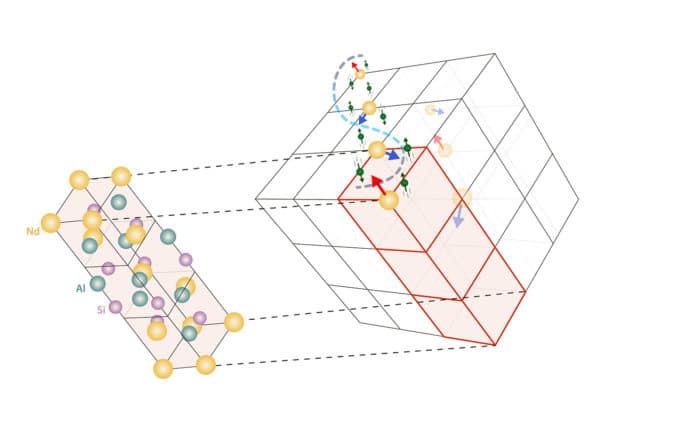Scientists at the National Institute of Standards and Technology (NIST) have discovered an exotic form of magnetism in a new crystal. This exotic form of magnetism has been linked to an equally exotic type of electrons. The crystal’s unique electronic structure creates and protects the magnetism.
The unusual structure of the material conducts electricity yet makes its electrons behave as massless particles. The electrons promote the spontaneous formation of a magnetic spiral.
The study reveals a link between the material, the electrons flowing through it as current, and the material’s magnetism.
In their study, scientists studied a semimetal made from silicon and the metals aluminum and neodymium. These elements come together to form a crystal, which implies that its component atoms are arranged in a regular repeating pattern.
However, a crystal breaks inversion symmetry, meaning that the repeating pattern is different on one side of a crystal’s unit cells—the smallest building block of a crystal lattice—than the other. This arrangement stabilizes the electrons flowing through the crystal, which drives unusual behavior in its magnetism.
The electrons’ stability shows itself as uniformity in the direction of their spins. Semimetal has broken symmetry that transforms the flowing electrons into Weyl electrons. Weyl electrons have spins oriented either in the direction the electron travels or in the exact opposite direction. This locking of the Weyl electrons’ spins to their direction of motion—their momentum—causes the semimetal’s rare magnetic behavior.
All atoms in material conduct electricity, giving steppingstones for electrons as they hop from atom to atom. However, only the neodymium (Nd) atoms exhibit magnetism. Due to the susceptibility to the influence of the Weyl electrons, the spin of Nd atoms pushes curiously.
Collin Broholm, a physicist at Johns Hopkins University who led the experimental work at the NIST Center for Neutron Research (NCNR), said, “A simplified way to imagine it is the first Nd atom’s spin points to 12 o’clock, then the next one to 4 o’clock, then the third to 8 o’clock. Then the pattern repeats. This beautiful spin ‘texture’ is driven by the Weyl electrons as they visit neighboring Nd atoms.”
“Each loop of the spin spiral is about 150 nanometers long, and the spirals only appear at cold temperatures below 7 K. There are materials with similar physical properties that function at room temperature and that they might be harnessed to create efficient magnetic memory devices.”
“Magnetic memory technology like hard disks usually requires you to create a magnetic field for them to work. With this class of materials, you can store information without applying or detecting a magnetic field. Reading and writing the information electrically is faster and more robust.”
“Fundamentally, we might be able to create a variety of materials that have different internal spin characteristics—and perhaps we already have. As a community, we have created many magnetic structures we don’t immediately comprehend. Having seen the special character of Weyl-mediated magnetism, we may finally be able to understand and use such exotic magnetic structures.”
Journal Reference:
- Gaudet, J. et al. Weyl-mediated helical magnetism in NdAlSi. Nat. Mater. (2021). DOI: 10.1038/s41563-021-01062-8
